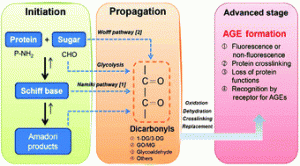This review from Gow-Chin Yen and co-workers in Taiwan reviews the anti-glycation properties of various foods and their mechanisms of action. Glycation, also known as the Malliard reaction is a type of nonenzymatic browning involving the reaction of carbohydrate with protein. It occurs ubiquitously in food, particularly during heating, processing and storage. It has also been implicated in accelerated aging and diabetic complications in vivo although the molecular basis of this pathogenesis is not well understood.
 Most studies to date have focused on the deleterious effects of toxic advanced glycation endproducts (AGEs) and it remains unclear whether phytochemicals, implicated in the reduction of toxic effects in clinical trials, actually exert protective effects against glycotoxin-induced damage. These natural potential AGE inhibitors may provide a therapeutic approach for delaying and preventing premature aging and diabetic complications.
Most studies to date have focused on the deleterious effects of toxic advanced glycation endproducts (AGEs) and it remains unclear whether phytochemicals, implicated in the reduction of toxic effects in clinical trials, actually exert protective effects against glycotoxin-induced damage. These natural potential AGE inhibitors may provide a therapeutic approach for delaying and preventing premature aging and diabetic complications.
Interested in knowing more? Read the full article by following the link below, all content in Food & Function is free to access until the end of 2011.
Inhibition of advanced glycation endproduct formation by foodstuffs
Chi-Hao Wu, Shang-Ming Huang, Jer-An Lin and Gow-Chin Yen
Food Funct., 2011, Advance Article
DOI: 10.1039/C1FO10026B










